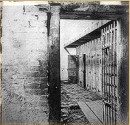



-Abraham Lincoln |
 |
SpecialListen To The Tavis Smiley Show (click here)Tavis Smiley talks with Edna Jordan Smith, founder of the Afro-Louisiana Historical & Genealogical Society, who has organized tours of former slave pens and auction houses. |
Historian uncovers tale of slave trade
Free black woman kidnapped in North
The Times Picayune
NEW ORLEANS and the Metro Area
Section B Tuesday February 25, 2003
By Joan Treadway staff writer
A young woman was strolling along a Philadelphia wharf, probably shopping for groceries or other goods in a riverfront market area, when she was abruptly kidnapped. Sarah Nicholson, 24, a free black person from nearby Wilmington, Del., had fallen into the hands of slave traders.
The abduction, on a summer day almost two centuries ago, marked the beginning of an appalling saga that saw Nicholson eventually transported to Louisiana, then transferred from one owner to another until she was offered for sale during an auction at the corner of Canal and Camp Streets.
Much of her long-buried story was uncovered recently by historian Edna Jordan Smith of Baton Rouge, a teacher of genealogical research and the founder of the Afro-Louisiana Historical and Genealogical Society.
Smith doesn't yet know for sure how Nicholson's story ended, but she plans to continue her research. Her findings so far shed light on the abduction of Northern black residents, a practice that flourished after the business of buying and selling slaves was banned, decades before slavery itself was abolished.
She is organizing tours along the routes slave dealers took, an ugly parallel to the Underground Railroad, which abolitionists used to get former slaves to freedom. And she intends to establish in Louisiana a system of markers for spots where black people were penned up or sold.
Nicholson's tale is similar to the one told in the memoir of New Yorker Solomon Northup, called “Twelve Years a Slave” - except it started about 15 years earlier, in 1826, Smith said.
Walter Hill, a senior archivist specializing in black history at the National Archives and Records Administration in Washington, D.C., said that Smith's discovery is not surprising. The U.S. Constitution permitted the slave trade until 1808, and when it became illegal, traffickers began smuggling in slaves from Africa and the Caribbean, and also began abducting free black people in the North as a labor pool for the South, he said.
Smith said that, as yet, she has no clue who kidnapped Nicholson, but that she has learned from her research that the people involved in this slave trade included both white people and free black people.
She first learned of Nicholson from a lawsuit that the woman filed on Aug.20 1827 in the St Helena Parish Court house in Greensburg. She found a summary of it in an old book of abstracts of cases in her own workplace, the public Bluebonnet Library in Baton Rouge. In the suit asking “that her freedom be decreed,” Nicholson was represented at no charge by an attorney named Thomas S. Lloyd, whom Smith believes was based in New Orleans.
One year earlier, the document stated, Nicholson had been “stolen from the Pine Street wharf” in Philadelphia and taken on board a hermaphrodite brig, a two-masted ship that was square-rigged forward and schooner-rigged aft. Then, she said, she was transferred to an oyster boat, which traveled down the Delaware River to an island.
“A storm rose in which the boat sprung a leak,” she said in the lawsuit, so Nicholson and nine other black people aboard were put back on the brig. In all, 50 people were enslaved there.
“Petitioner was put in irons, being ironed at the right foot, and a rope was fastened around her neck to the neck of another of the company, in the manner that oxen are bound,” the suit said.
The ship made several stops en route to Louisiana, where Nicholson was then transported, by land, to St. Helena Parish, the document stated. Smith believes that she could have been simply taken down the Atlantic coast, and then into the Gulf of Mexico.
Nicholson was first owned by Presley Stephenson, a cotton farmer, who probably used her as a field hand for a while, Smith said. He eventually brought her to New Orleans and sold her to a “Captain Thompson,” who dealt in slaves downtown at the corner of Canal and Camp.
In the suit, she stated that she was being forcibly held by Thompson, whom she claimed had “cruelly whipped her himself” and had had her whipped “at the police station, for saying she was free.”
She demanded not only her liberty but also an unspecified amount of damages from Thompson for her suffering.
Smith plans to go to St. Helena soon to try to find out what happened with Nicholson's case and also wants to further check official records in both New Orleans and Wilmington.
A review of old census information suggests Nicholson may have made it back home.
In the 1820 census, there was an “all female, free black household” in Wilmington, headed by a Sidney Nicholson, whom Smith believes was Sarah's mother. Ten years later, Sidney is still listed there and so is an unnamed younger woman.
“Sarah may have made it back by then,” Smith said
By 1840, the only Nicholson mentioned in the Wilmington area is a Sarah, but she's classified under “free white”. “Maybe she was trying to pass for white, in fear of being kidnapped again,” Smith said.
Records from 10 years later turned up someone else named Sarah Nicholson, but she was living in an “alms house” and was described as “simple”. She was 19, and Smith wonders whether the teenager was the kidnap victim's daughter.
Contact Us | Homepage